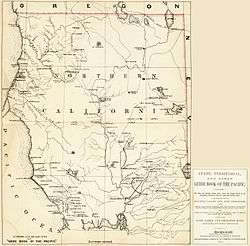Fort Baker (Humboldt County)
Fort Baker, in Humboldt County, California was an outpost of the Union Army for the Bald Hills War from 1862 to 1863. It was located 14 miles (23 km) east of Bridgeville on State Highway 36 on the west bank of Van Duzen Creek in Larabee Valley. The site of Fort Baker has been obliterated by frequent flooding.[1]

Fort Baker was established by Col. Francis J. Lippitt, commander of the Humboldt Military District as one of a number of posts to protect the settlers. It was the center of continued aggressive patrolling that finally forced Lassic and his Wailaki band to surrender on July 31, 1862, at Fort Baker. More of his warriors plus those of other bands came in on August 10 and the 212 captured Indians at Fort Baker were sent to join 462 others at Fort Humboldt. After the 850 captured hostiles were sent to the Smith River Reservation it was believed the war was nearly over. However Lassic and other warriors escaped and the war continued.[2]
On September 7, 1863, Fort Baker was recommended for closure, to be replaced by Fort Iaqua. Fort Baker was abandoned before the end of 1863 and was burned on May 11 or 12, 1864 by persons unknown,[1] suggestions included Confederate sympathizers or Indians.[3]
References
- "Fort Baker". Historic California Posts. California Military Museum, California State Military Department. 2013. Retrieved November 4, 2013.
- Robert Nicholson Scott,; George Breckenridge Davis; Leslie J. Perry; Henry Martyn Lazelle; Joseph William Kirkley; Fred Crayton Ainsworth; John Sheldon Moodey (1897). The War of the Rebellion: a compilation of the official records of the Union and Confederate armies, Volume 27, Part 1, Chapter LXII. Operations on the Pacific Coast, January 1, 1861 to June 30, 1862. Washington, D.C.: U.S. War Department, U.S. Government Printing Office. pp. 168–170. Retrieved December 18, 2012.CS1 maint: extra punctuation (link)
- "California Forts". American Forts West. 2013. Retrieved 5 November 2013.
Further reading
- Historic Spots in California, Third Edition. Historic Spots in California, Third Edition. Stanford University Press. pp. 100–. ISBN 978-0-8047-4020-3.
